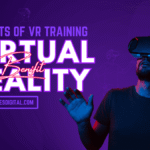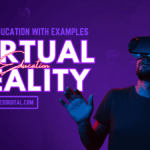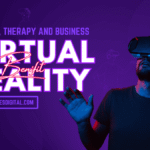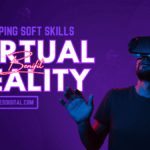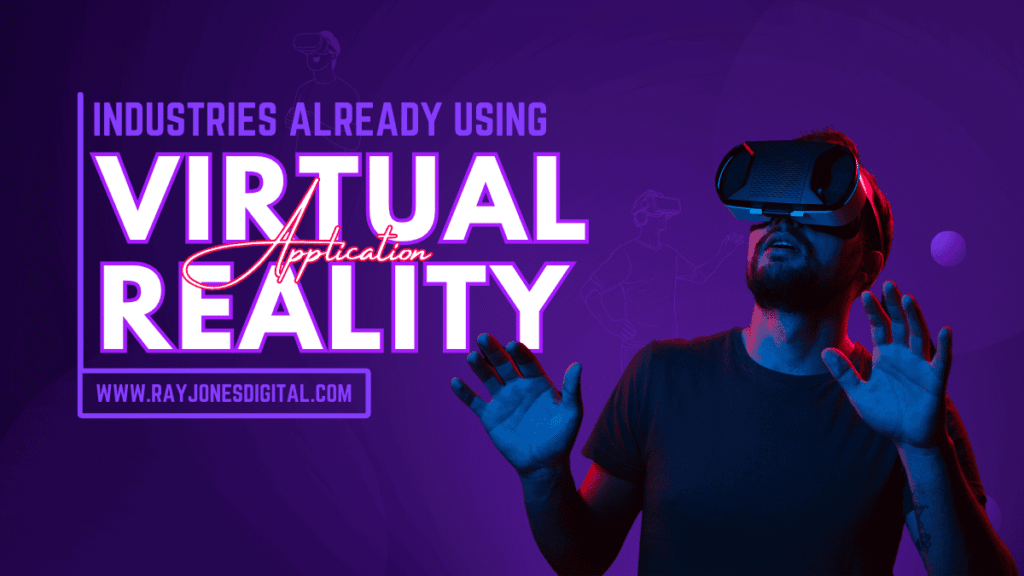
VR Application has evolved from a futuristic concept to a practical business tool reshaping multiple industries. Companies across sectors are discovering that VR technology offers unique solutions to longstanding challenges, from training employees to engaging customers in revolutionary ways.
This comprehensive guide explores the key industries successfully implementing VR applications, demonstrating how immersive technology is transforming business operations and creating competitive advantages. Whether you’re considering VR adoption or simply curious about its real-world applications, these industry examples reveal the tangible benefits and practical uses of virtual reality technology.
Healthcare: Revolutionising Patient Care and Medical Training
The healthcare industry has emerged as one of the most innovative adopters of VR technology, using immersive experiences to improve patient outcomes and enhance medical education.
Medical Training and Simulation
Medical schools and hospitals use VR to provide risk-free training environments where students and professionals can practice complex procedures without endangering patients. VR surgical simulators allow trainee surgeons to perform operations repeatedly, building muscle memory and confidence before entering real operating theatres.
The technology enables medical students to explore detailed 3D anatomical models, walking through virtual human bodies to understand complex physiological systems. This immersive approach to learning anatomy has proven more effective than traditional textbooks and static models.
Emergency response training benefits significantly from VR simulations. Medical teams can practice responding to rare but critical situations, such as mass casualty events or complex trauma cases, in controlled virtual environments that replicate real-world stress and time pressures.
Patient Treatment and Therapy
VR therapy applications help patients manage pain, anxiety, and various mental health conditions. Pain management programmes use immersive experiences to distract patients during medical procedures, reducing the need for pharmaceutical pain relief.
Phobia treatment through VR exposure therapy allows patients to confront their fears in safe, controlled environments. Patients with claustrophobia, fear of heights, or social anxiety can gradually build tolerance through carefully designed virtual experiences.
Physical rehabilitation programmes incorporate VR to make therapy more engaging and effective. Stroke patients recovering motor function can practice movements through virtual games and exercises that feel more like entertainment than medical treatment.
Surgical Planning and Visualisation
Surgeons use VR to plan complex operations by creating detailed 3D models of patient anatomy from medical imaging data. This pre-operative planning reduces surgery time and improves patient outcomes by allowing surgeons to identify potential complications before making incisions.
The technology enables collaborative surgical planning, where multiple specialists can examine virtual patient models simultaneously and discuss treatment approaches. This collaboration improves decision-making and ensures comprehensive care planning.
VR also assists during actual surgeries, overlaying digital information onto the surgeon’s view of the patient. This augmented approach helps surgeons navigate complex anatomy and avoid critical structures during delicate procedures.
Education: Transforming Learning Experiences
Educational institutions are leveraging VR to create immersive learning environments that enhance student engagement and comprehension across all academic levels.
Interactive Learning Environments
VR enables students to explore historical events, scientific phenomena, and geographical locations in ways previously impossible. History students can walk through ancient Rome, whilst biology students can observe cellular processes from inside virtual cells.
Language learning benefits from VR’s ability to create authentic cultural contexts. Students can practice conversational skills with virtual native speakers in realistic settings, from ordering food in a Parisian café to conducting business meetings in Tokyo.
Science education becomes more engaging through virtual laboratories where students can conduct experiments without safety concerns or resource limitations. Chemistry students can observe molecular interactions, whilst physics students can manipulate virtual forces and observe their effects.
Skills Training and Vocational Education
Technical training programmes use VR to provide hands-on experience with expensive or dangerous equipment. Aviation students can practice flying in virtual cockpits, whilst engineering students can operate heavy machinery without risk or cost.
Soft skills training through VR helps students develop communication, leadership, and teamwork abilities. Virtual scenarios simulate challenging interpersonal situations, allowing students to practice responses and receive feedback on their performance.
Professional certification programmes incorporate VR to provide standardised training experiences. This consistency ensures that all learners receive equivalent preparation regardless of their physical location or available resources.
Distance Learning and Accessibility
VR technology breaks down geographical barriers in education, allowing students from remote locations to access high-quality learning experiences. Virtual classrooms enable real-time interaction between students and instructors across continents.
The technology also improves accessibility for students with disabilities. Mobility-impaired students can explore virtual environments they might not otherwise access, whilst students with learning disabilities benefit from multi-sensory immersive experiences.
Collaborative learning projects become possible through shared virtual spaces where students can work together on complex problems, regardless of their physical locations.
Retail: Enhancing Customer Experience and Sales
Retail businesses are using VR to create innovative shopping experiences that bridge the gap between online and physical retail environments.
Virtual Showrooms and Product Demonstrations
Furniture retailers use VR to let customers visualise products in their own homes before purchasing. Customers can see how sofas, tables, and décor items will look in their actual living spaces, reducing uncertainty and returns.
Automotive dealerships create virtual showrooms where customers can explore vehicle interiors, customise options, and even take virtual test drives. This technology is particularly valuable for luxury vehicles or custom configurations that dealers cannot stock physically.
Fashion retailers develop virtual fitting rooms where customers can try on clothing without physically changing. This technology addresses sizing concerns and reduces return rates whilst providing convenient shopping experiences.
Immersive Brand Experiences
Luxury brands create exclusive VR experiences that tell their stories and showcase craftsmanship. Watch manufacturers might take customers on virtual tours of their Swiss workshops, whilst fashion brands recreate runway shows or design studios.
Travel companies use VR to give customers previews of destinations, hotels, and activities. Potential travellers can explore cruise ships, hotel suites, and tourist attractions before booking, increasing confidence in their purchasing decisions.
Beauty brands offer virtual makeup trials where customers can experiment with different products and looks without physically applying cosmetics. This try-before-you-buy approach increases customer satisfaction and reduces product returns.
Training and Customer Service
Retail employees benefit from VR training programmes that simulate various customer service scenarios. Staff can practice handling difficult situations, product demonstrations, and sales techniques in risk-free virtual environments.
Customer service representatives use VR to better understand products and services, leading to more informed and helpful interactions with customers. This enhanced knowledge translates to improved customer satisfaction and increased sales.
Store layout optimisation benefits from VR testing, where retailers can experiment with different arrangements and observe customer behaviour patterns before implementing physical changes.
Manufacturing: Streamlining Operations and Training
Manufacturing companies are adopting VR technology to improve efficiency, reduce costs, and enhance worker safety across production facilities.
Employee Training and Safety
VR safety training allows workers to experience dangerous situations without actual risk. Employees can practice emergency procedures, hazard recognition, and equipment operation in virtual environments that replicate real workplace conditions.
Complex machinery operation training becomes more effective through VR simulations that let workers practice on virtual equipment before handling expensive real machinery. This approach reduces training costs and minimises equipment damage during learning phases.
Quality control training uses VR to teach workers how to identify defects and maintain production standards. Virtual scenarios present various quality issues that workers must recognise and address, building expertise without disrupting actual production.
Product Design and Prototyping
Engineering teams use VR to visualise and test product designs before creating physical prototypes. This virtual prototyping reduces development costs and accelerates time-to-market by identifying design flaws early in the process.
Collaborative design sessions benefit from VR environments where team members can examine and modify virtual prototypes together, regardless of their physical locations. This collaboration improves design quality and reduces revision cycles.
Assembly line planning uses VR to optimise workflow and identify potential bottlenecks before production begins. Manufacturers can test different configurations and procedures virtually, ensuring efficient operations when physical production starts.
Remote Assistance and Maintenance
Field service technicians use VR-enabled remote assistance to receive guidance from experts during complex repairs. Remote specialists can see through the technician’s perspective and provide real-time instructions, reducing service time and improving repair quality.
Predictive maintenance programmes incorporate VR to help technicians visualise equipment conditions and maintenance requirements. Virtual overlays show component wear patterns, replacement schedules, and maintenance procedures.
Training programmes for maintenance personnel use VR to simulate various equipment failures and repair scenarios. This comprehensive training ensures that technicians can handle diverse situations effectively.
Real Estate: Transforming Property Marketing and Sales
The real estate industry has embraced VR technology to overcome traditional limitations in property viewing and marketing.
Virtual Property Tours
VR property tours allow potential buyers to explore homes remotely, saving time and expanding market reach. Buyers can walk through properties at their convenience, examining details and getting genuine feelings for spaces without scheduling physical visits.
International property investment benefits significantly from VR tours, enabling investors to evaluate properties in different countries without travelling. This accessibility opens new markets and investment opportunities previously limited by geographical constraints.
Property developers use VR to market properties before construction completion. Potential buyers can tour virtual representations of planned developments, enabling pre-sales and providing valuable market feedback during the development process.
Interior Design and Renovation Planning
VR interior design services let clients visualise renovation projects before construction begins. Homeowners can experiment with different layouts, materials, and colour schemes, ensuring satisfaction with design choices before making expensive commitments.
Architectural firms use VR to present design concepts to clients more effectively than traditional blueprints or renderings. Clients can walk through proposed buildings and experience spatial relationships, leading to better design decisions and fewer revisions.
Commercial property developers use VR to help tenants visualise office layouts and customisation options. This technology accelerates leasing processes and reduces tenant concerns about space suitability.
Investment and Market Analysis
Real estate investors use VR to evaluate multiple properties efficiently, comparing locations, conditions, and potential returns without extensive travel. This efficiency enables more thorough market analysis and better investment decisions.
Property valuations benefit from VR documentation that preserves detailed property conditions for future reference. Appraisers can revisit virtual property records to track changes and verify conditions without repeated physical inspections.
Market research applications use VR to test consumer preferences for different property features and layouts. This data helps developers and investors understand market demands and optimise their offerings accordingly.
Entertainment: Creating Immersive Experiences
The entertainment industry continues to push VR boundaries, developing innovative applications that redefine how audiences experience media and entertainment.
Gaming and Interactive Entertainment
VR gaming provides unprecedented immersion levels, placing players directly inside virtual worlds. Action games, puzzle games, and simulation experiences offer engagement levels impossible with traditional gaming platforms.
Multiplayer VR experiences enable social gaming where friends can interact in virtual spaces, participating in cooperative adventures or competitive challenges. These social elements strengthen gaming communities and extend playing time.
Educational gaming combines entertainment with learning, making complex subjects more engaging through interactive VR experiences. History, science, and mathematics become more accessible through gamified virtual environments.

I am Ray Jones Digital
My current occupations: a Digital Marketer, Local SEO expert, Link Builder, and WordPress SEO specialist. Shopify SEO, Ecommerce Store Management, and HTML & WordPress Developer I have been practicing the above mentioned services for more than 10 years now As an SEO expert working with your ongoing projects.
